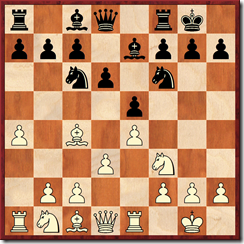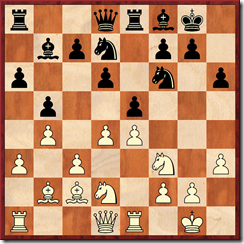This article was originally published as a web extra for US Chess Online. It contains comparative analysis originally done for my May 2016 review in Chess LIfe. I reprint it here, mainly so that readers can have access to the analysis in text format as well as in replayable format via the ChessBase website.
—–
One of the great difficulties of reviewing chess books is dealing with all of the analysis. The days of Fred Reinfeld and his breezy notes are long gone, and in their place, we get variations analyzed into the ground with the help of our ‘metal friends.’ The results can be mind-numbing. Sometimes I wonder whether today’s authors don’t analyze more than even they think they need to, lest a Stockfish-armed reader loudly find them sloppy.
In this month’s Chess Life column, I reviewed six books and one database dealing with 1.e4 e5 from the Black side of the board. I generated a lot of analysis along the way, but the realities of word counts and page space intervened, and the bits I’d wanted to include were relegated to the cutting room floor.
But there are no word counts on the Internet.
Perhaps it’s appropriate here to make something of an admission. There is no human way for me to play through every variation on every page of modern books, much less subject everything to critical scrutiny with the machine and my limited common sense. This is particularly true in cases like this month, where I try to give readers useful reviews of more than one title. Some strategy is required, where I can balance the requirements of objective criticism with the limits of my time and capabilities.
After some trial and error, I have settled on a standard methodology. The first thing I do when reviewing a book is read through it without a board, trying to get a sense of it on a macro-level. After that initial read, I try to engage the author on a micro-level, going through the text in ChessBase and with an engine. Here two different tasks become important.
First, I try to find points of convergence between books, places where the analysis overlaps. What do different authors recommend? Why? And what does that reveal about their authorial style, the quality of their work, etc.?
I also like to ‘drill deep’ into certain positions to test depth and originality. This usually (in the case of opening books) involves subjecting key opening tabiya to heavy computer-aided scrutiny. It can also include choosing lesser-known side lines to see if the authors bring anything new to the table, or if they are content to trade in the usual solutions.
Both of these elements came to bear on my May review. I spent some time comparing the various responses to the Belgrade Gambit, for example, and I discovered that the main lines of the Breyer can be incredibly complicated to analyze. It was a lot of fun, especially for this sometimes 1…e5 player, but man… there is a ton of theory.
For this web extra I chose two bits of analysis that might be of use to readers while also giving some sense of the books in the May review. The first is an overview of recommendations in the Italian, with a focus on the trendy variations that include an early a2-a4. The second is a more in-depth study of a popular line in the Zaitsev, where we see something of the divergent approaches of Kuzmin and Solozhenkin.
7.a4 Giuoco Piano [C54]
27.02.2017
[Hartmann,John]
1.e4 e5 2.Nf3 Nc6 3.Bc4 Nf6 4.d3
(A) Avrukh (via the 3…Bc5 move order) and Bologan prefer 4…Bc5 5.c3 d6 6.0–0 and here paths diverge:
6…a6 Avrukh (6…0–0 Bologan, “Adams Approach” 7.Bb3 (7.Nbd2 a5) 7…a5!?) 7.a4 0–0 (7…h6; 7…Ba7) 8.Bg5 h6 9.Bh4 g5 and:
a) 10.Nxg5 “not too dangerous for Black” 10…hxg5 11.Bxg5 Kg7 12.Qf3 Rh8 13.Nd2 Kg6 is from Caruana,F (2804)-Nakamura,H (2787) Paris 2016 (0-1 in 32 moves). Avrukh gives the improvement 14.Be3 Kg7 15.Bg5 Kg6 and Black “has at least a draw.”
b) 10.Bg3 Ba7 11.Nbd2 (11.Na3 Bg4 12.Nc2 d5!?) 11…Kg7 12.Re1 Nh7 with kingside expansion.
(B) Bologan, Lokander, and Ntirlis recommend 4…Be7 5.0–0 0–0 6.Re1
Other White options:
a) 6.c3 allows 6…d5!? (Bologan) but the simplest repertoire choice is 6…d6 (Ntirlis)
b) 6.Bb3 d6 (6…d5 Bologan) 7.c3 Na5!? (Ntirlis) 8.Bc2 c5
c) 6.a4 d5! Ntirlis, Bologan
6…d6 7.a4 In this position, Bologan, Lokander and Ntirlis recommend different moves for Black:
Bologan: 7…Be6 “Modern Line” 8.Nbd2
a) 8.a5 b6!? 9.Bxe6 fxe6 10.d4 (10.a6 Nd4) 10…exd4 11.Nxd4 Nxd4 12.Qxd4 d5!
b) 8.Nc3 Nd4 9.h3 Nxf3+ 10.Qxf3 c6=
c) 8.c3 Qd7 9.a5 b6?!
d) 8.Bxe6 fxe6 9.c3 Qd7 10.Nbd2 Nh5 11.Nc4 Qe8 wti …Qg6
8…Qd7 9.c3 (9.Nf1 Rfe8 10.Ng3 d5 11.Bb5 (11.exd5 Bxd5) 11…dxe4 12.dxe4 (12.Nxe5 Qd6) 12…Qxd1 followed by …Red8) 9…Rfe8 (9…a6) 10.a5 (10.Bxe6 Qxe6 wti ..d5; 10.b4 a6 11.Bb2 Bf8) 10…a6 11.Bb3 (11.Qb3 Rab8 12.Nf1 Bxc4 13.Qxc4 Red8=) 11…Bxb3 12.Qxb3 d5
Lokander: 7…Kh8!? 8.Nc3
a) 8.h3 h6! (8…Ng8 9.Nc3 f5 10.Nd5 Bf6 11.b4 +=)
b) 8.c3 Ng8 9.d4 f5 10.dxe5 (10.exf5 d5; 10.d5 Nb8) 10…fxe4 11.Rxe4 Rxf3! 12.gxf3 Nxe5 13.Rxe5 dxe5 14.Qxd8 Bxd8 15.Nd2 Nf6 16.Ne4 Nxe4 17.fxe4 Bg4 18.Kg2 Bh4 19.f3 Bh5 20.Be3 Rd8 21.b4 h6 ½–½ (21) Fedorchuk,S (2635)-Giri,A (2722) Germany 2012
8…Bg4! 9.h3 Bh5 10.Be3
10.g4? Nxg4! 11.hxg4 Bxg4 12.d4 (12.Be3 f5!) 12…Nxd4 13.Be2 Nxe2+ 14.Qxe2 f5 15.Qe3 f4 16.Qd3 Rf6 17.Kf1 Rh6–+ 0–1 (32) Oparin,G (2343)-Khruschiov,A (2419) Moscow 2010
10…Nd4 [10…Nb4 11.Bb3 a5] 11.Bxd4 exd4 12.Nb5 c5 13.c3 dxc3 14.Nxc3 Bxf3 15.Qxf3 Nd7=
Ntirlis: 7…Na5 8.Ba2 c5 9.Na3! ‘critical plan’ (Ntirlis)
a) 9.Bg5!? Nc6 10.Bxf6 Bxf6 11.Nc3 Nb4!
b) 9.Nc3 Nc6 10.Nd5 Nxd5 11.Bxd5 Be6 12.c3 Qd7 13.Be3 Bf6!? Ntirlis via Marin
9…Nc6 10.c3 h6 (10…Be6 was Lokander’s rejected line, i.e. 11.Bxe6 fxe6 12.Nc4) 11.Bd2 (Saric, Chess24) 11…a6!
Zaitsev 12.a3 h6 13.Bc2 (edited) [C93]
27.02.2017
[Hartmann,John]
1.e4 e5 2.Nf3 Nc6 3.Bb5 a6 4.Ba4 Nf6 5.0–0 Be7 6.Re1 b5 7.Bb3 d6 8.c3 0–0 9.h3 Bb7 10.d4 Re8 11.Nbd2 Bf8 12.a3 Very popular recently.
Other options: 12.a4 (Kasparov’s move, deeply analyzed today); 12.d5 (Khalifman’s recommendation); and 12.Bc2.
12…h6 The main line, analyzed by Solozhenkin in ch 22 and Kuzmin in ch 5–7.
12…Qd7 is very rare and the subject of chapter 8 of Kuzmin’s book. After 13.Bc2 Kuzmin analyzes 13…d5!?, a novelty inspired by Tal-Gligoric (Moscow, 1967).
13.Bc2 (K, ch 5)
Less often played are 13.Ba2 (K, ch 6) and 13.d5 (K, ch 7).
13…Nb8
13…d5!? (S p175) 14.dxe5 Nxe5 15.Nxe5 Rxe5 16.Nf3 Re8 17.e5 Ne4 18.Bf4 c5 19.a4 f5 20.Qe2 b4 1–0 (40) Oparin,G (2563)-Morozevich,A (2692) Moscow 2015 (20…Qd7!?; 20…Qb6!?)
14.b4
14.b3 is another huge line. See K p.90 and S p.175
14…Nbd7 15.Bb2
Other ideas for White include:
15.d5?! c6 16.c4 Nb6 17.dxc6 Bxc6 =+ S
15.a4 Nb6 16.a5 Nbd7 17.Bb2 exd4!? (17…Rb8) 18.cxd4 c5 with counterplay K
This is the key tabiya. No less than four moves are analyzed by Kuzmin and Solozhenkin. 15…g6 is Black’s most popular try, but Solozhenkin dismisses it, saying that Black will “need to defend several possible positions… all of them are much easier to play with White.” (p176)
Variation #1: 15…c5 K p97: “most critical course;” also briefly discussed by S. 16.bxc5
After 16.d5 play can follow:
a) 16…c4 17.a4 Nh5 18.Bc1! +=/= (18.Nf1 f5!)
b) 16…a5!? 17.bxa5 (17.Nb3 a4 18.Na5 Rxa5 19.bxa5 c4 with counterplay) 17…Qxa5 18.a4 with initiative Reb8
c) 16…Qc7 17.Nb3 Rac8! 18.Nfd2 Nb6 19.Na5 Ba8 20.Rc1 c4 with counterplay ½–½ (46) Montero Gabarro,J-Rosa Ramirez,V (2301) ICCF email 2008
16…exd4 17.cxd4
a) 17.cxd6 dxc3 18.Bxc3 Bxd6 19.e5 Nd5 20.Bb2 Bc7 =/=+
b) 17.c6 dxc3 18.cxb7 cxd2 19.Qxd2 Rb8 20.Rad1 Qc7! White has sufficient comp but not more (20…Rxb7?! 21.e5!)
17…dxc5 18.d5 (18.Bb1 Qb6 19.e5 Nd5 20.Ne4 ½–½ (20) Karpov,A (2690)-Smejkal,J (2535) Moscow 1981) 18…c4 19.Bc3
a) 19.Nd4 Qa5!? (19…Qc7 20.Bc3 transposition) 20.Re3 Bc5
b) 19.Bd4 Nh5!? 20.Nf1 Nc5 unclear/=
19…Qc7 (19…Bc5!? 20.a4= (20.Nd4? Qb6 –/+; 20.Rb1=; 20.Nf1 a5 21.Bd4 Qb6 with initiative ) 20.Nd4 g6 (20…Ne5 21.Nf5 g6 (21…Bc8) ) 21.N2f3 Bg7 1–0 (34) Lastin,A (2616)-Kasimdzhanov,R (2685) Plovdiv 2010.
Variation #2: 15…a5 K p99 16.Bd3!
a) 16.dxe5 dxe5 (16…Nxe5 is simpler) 17.Qe2 c6 18.Nb3 axb4 19.cxb4 Qb6 1–0 (50) Zhigalko,S (2678)-Saric,I (2671) Tromsoe 2014
b) 16.Rb1 c6 17.Nb3 axb4 18.cxb4 exd4 19.Nfxd4 c5!= ½–½ (48) Palac,M (2581)-Kuljasevic,D (2558) Opatija 2015
16…c6 17.Nb3
a) 17.Qc2 Rc8!? 18.Nb3 (18.Rac1 axb4 19.cxb4 (19.axb4 Qc7) 19…c5! with counterplay) 18…axb4 19.axb4 exd4 20.cxd4 c5! unclear 0–1 (34) Baron,T (2465)-Kuljasevic,D (2564) Skopje 2013
b) 17.Qb1!? axb4 18.cxb4 Qb6 (better is 18…exd4 19.Nxd4 Qb6=) 19.Bc3 Nh5 (19…Rad8?! 20.a4! +=(20.Qb2 ½–½ (31) Leitao,R (2571)-Vescovi,G (2590) Sao Paulo 2002))
c) 17.Rc1!? axb4 18.cxb4 exd4 19.Nxd4 Qb6
17…axb4 18.cxb4 exd4 19.Nfxd4 c5 20.bxc5 dxc5 21.Nxb5 Nxe4= 0–1 (32) Hjartarson,J (2615)-Karpov,A (2750) Seattle 1989
Variation #3: 15…c6!? K p101 16.Rc1
a) 16.Nb3 Rc8 17.Na5 Ba8=;
b) 16.c4 exd4 17.Nxd4 c5 18.bxc5 Nxc5„ ½–½ (55) Timofeev,A (2661)-Jakovenko,D (2627) Saint Vincent 2005
c) 16.Bd3 c5!
d) 16.Qb1 Nb6= (16…c5 17.Nb3)
16…a5!? (16…Rc8 17.Bb1² ½–½ (89) Ponomariov,R (2718)-Ivanchuk,V (2781) Moscow 2008) 17.Bd3!? transposes to 15…a5 (17.c4 axb4 18.axb4 bxc4 19.Nxc4 exd4 20.Nxd4 d5 21.Na5 Qb6=; 17.Bb1 Nb6) 17…axb4 18.cxb4 exd4 19.Nxd4 Qb6
Variation #4: 15…Nb6 Solozhenkin p176 16.dxe5 White has many choices here:
a) 16.a4 exd4 17.cxd4 bxa4=
b) 16.Rb1 Nfd7= (16…Rc8 1–0 (81) Tan,M (2400)-Zult,D (2241) Amsterdam 2011)
c) 16.Re3 Rc8 17.Qb1 Nfd7 18.Re1 Qf6 19.Qa2 d5 20.Rad1 Bd6=
d) 16.Qb1 Nh5 17.Re3 (17.g3 Qd7 18.Kg2 a5„) 17…Nf4 18.Qf1 exd4 19.cxd4 d5 20.e5 Nc4 with counterplay
e) 16.c4 exd4 17.cxb5 axb5 18.Nxd4 Na4 19.Bxa4 bxa4 20.Qc2 (20.Qf3 c5 21.Nf5 Re6 unclear) 20…c5 21.bxc5 dxc5 22.Nf5 Nh5!? 23.Rad1 Qg5 24.Nf3 Qf4= 0–1 (34) Petrov,Y (2309)-Schulz,G (2411) ICCF email 2012
f) 16.Rc1 Nfd7 17.c4
f1) 17.d5 c6 18.dxc6 Bxc6 19.Bb3 a5 20.c4 axb4 21.axb4 Nf6=;
f2) 17.Qe2 exd4 18.cxd4 c5 19.dxc5 dxc5 20.e5 (20.bxc5 Nxc5 21.e5 Rc8 22.Red1 Qe7 23.Bc3 Nd5 =+ 0–1 (39) Krebs,J (2097)-Schulz,G (2127) GER email 2010) 20…c4 21.Be4 Qc7 22.Bxb7 Qxb7=
17…bxc4 18.Bb1 exd4 (18…a5 ½–½ (30) Romanishin,O (2585)-Zhidkov,V (2460) Simferopol 1983) 19.Bxd4 a5 20.Nxc4 Nxc4 21.Rxc4 axb4=
16…dxe5 17.c4 c5!?
17…bxc4 18.Nxe5 c5 19.Ndxc4!? (19.Bc3 cxb4 20.axb4 ½–½ (43) Yagupov,I (2450)-Zaitsev,I (2447) Orel 1999 20…Qc7 with counterplay) 19…Nxc4 20.Nxc4 cxb4 21.e5 Rc8 22.exf6 (22.Bd3 Nh5 23.Bf1 Nf4 24.Qg4 Nxg2! 25.Red1 Qh4 unclear) 22…Rxc4 unclear
18.cxb5
18.bxc5 Nbd7!? 19.cxb5 axb5 20.Qe2 Bxc5 21.Nb3 (21.Qxb5? Ba6 22.Qb3 Rb8 23.Qa2 Qb6 –/+) 21…Bf8!? (21…Qb6 ½–½ (23) Matsenko,S (2461)-Nijboer,F (2582) Hoogeveen 2010) 22.Qxb5 Ba6 23.Qa5 Qb8 with compensation
18…cxb4!?
18…axb5 19.Nxe5 Nfd7 with compensation (19…c4 with compensation)
19.bxa6 Bxa6 20.Nxe5
20.axb4 Bxb4 21.Bb3 Qd6!?
20…bxa3 21.Nxf7!? axb2! 22.Nxd8 bxa1Q 23.Qxa1 Rexd8 S: All three outcomes are possible 24.Qa5 Nfd7 25.e5 Bd3! 26.Qc3 Nc5 27.Bxd3 Nxd3 28.Re3= ½–½ (28) González Pereira,F (2453)-Oreopoulos,K (2450) ICCF 2013.







